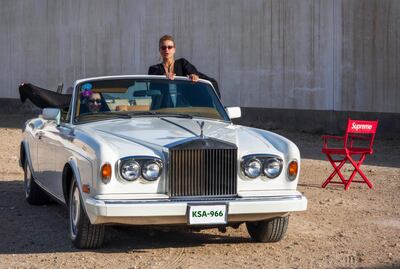Typical #Saudigirlproblems of the past included getting your abaya caught in the wheels of a chair or stuck in the door of the car, according to Marriam Mossalli, founder of luxury communications consultancy, Niche Arabia. But the roles of women are evolving in the kingdom, making room for a more empowered female population and with it, more practical, versatile wardrobes that are still every bit stylish.
When it comes to women's clothing in Saudi Arabia, Mossalli is something of an expert. Two years ago, she published the first edition of Under the Abaya: Street Style from Saudi Arabia, a collection of images displaying the sartorial styles of women in the kingdom.
The second volume of the book was released last week, and while fashion trends have not witnessed any dramatic changes since 2018, domestic policies – specifically those relating to females – have undergone some progressive reforms, which have influenced how Saudi Arabian women use fashion to express their identities.
The kingdom has announced a number of initiatives to encourage women to enter the workforce as part of its Vision 2030 goals – most notably, allowing them to obtain driving licences. This landmark ruling inspired the book's release date – volume two of Under The Abaya launched on June 24, exactly two years after the historic decision to lift the ban on female drivers.
Many of the photographs in the new edition aptly feature some trailblazing women in the driver's seats of their cars. Popular niqab-wearing influencer Amy Roko, who also starred in a Benefit cosmetics campaign earlier this year, is pictured in the new book, along with race car drivers Reema Juffali and Aseel Al Hamad, and motorbike racer Dania Akeel.
In total, more than 300 Saudi women appear on the 330 pages of Under the Abaya, in a variety of outfits that include everything from on-trend mum jeans and denim jackets to sleek sportswear and a variety of abayas.
Mossalli tells The National that the kingdom's reforms have been instrumental in influencing new fashion requirements among the country's women.
“It has definitely encouraged a more versatile lifestyle, and what I’ve noticed is that it has reflected in their wardrobe choices,” she says. “In the past we used to have these very decadent, heavy pieces of abayas as our outerwear because that was reflective of our lifestyle. We were going to dinners, we were sitting down with our friends and women who lunch and all of that, but with the entry of women in the workforce, we are seeing clothing that is a little more work-friendly.”
With women taking on more active roles, ornately decorated abayas with superfluous fabrics are no longer in vogue. “We went from having heavy abayas not suitable for work to these very easy, shorter abayas that do not get caught in the wheels of your office chair, or your car door, because now we are driving,” says Mossalli.
“Now, fashion is not just for show, it is something that these girls can live in and be active in,” she notes.
While it was also announced in 2018 that abayas would no longer be legally enforced, Mossalli explains that women in the kingdom – particularly millennials – are not parting with the traditional garment just yet.
“Our youth are very much like the Japanese back in the '90s, where you saw this influx of youth culture getting back in touch with their cultural roots, and we saw that in their fashion design as well and in the things they were creating, and the same could be said for Saudi Arabia.
"We are very proud of and conscious about our culture and heritage, and it’s important for us to show that – the abaya is one way to do that. What we are seeing is [the abaya] just kind of evolve,” she says, referencing the shorter lengths, tailored silhouettes and range of colours now available among designers in the Gulf.
With dress code reforms having paved the way for more freedom of expression when it comes to style in the public sphere, it's an exciting time for Saudi fashion, and Mossalli sees potential for Under the Abaya to become a more long-term project. "I definitely see this book becoming an ongoing thing, who knows, maybe we can make it a foundation one day, that's my dream … but basically, as long as we have the need for women empowerment, and that is not going to end soon, it's an ongoing journey," she says.
The book's editor says the Under The Abaya project is a non-profit one, and that all of the money from its sale will go towards providing higher education for underprivileged Saudi women.
“All of this is to raise money for scholarships,” says Mossalli, “and with Covid and all of these things that have happened to our economy, it is more important now than ever.”
















